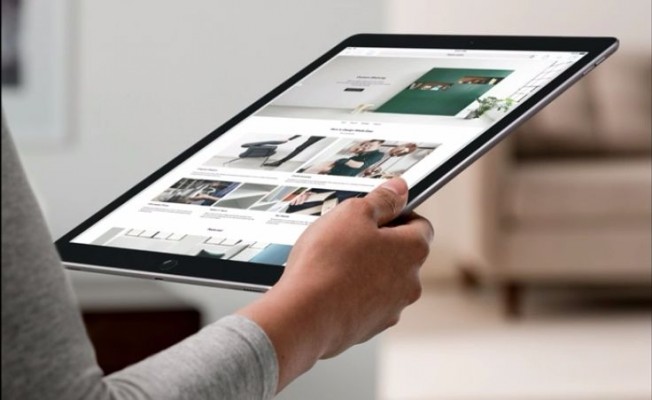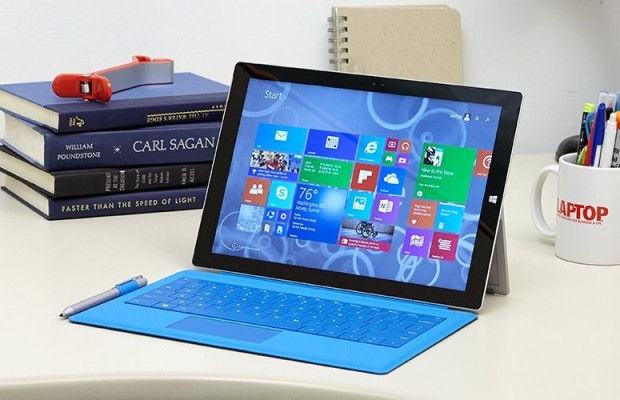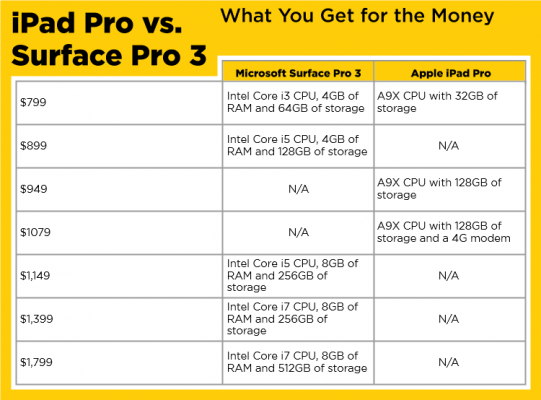iPad Pro vs. Microsoft Surface Pro 3: What Should You Buy?
Apple's new iPad Pro is big news, but it isn't the only big-screen tablet out there that's designed to help you work. The Microsoft Surface Pro 3 has been targeting business users and creative professionals for over a year now. Both Apple's and Microsoft's slates have a keyboard and stylus accessory, both can run Microsoft Office, and both start at $799. But there are quite a few differences as well.
Although there’s a Surface 4 likely on the way in October, here’s how Microsoft’s and Apple’s latest devices compare right now.
Display and Size
The iPad Pro packs the biggest display ever seen on an iPad, with a 12.9-inch screen that boasts 2732 x 2048 pixels of resolution. That's 5.6 million pixels. The Surface Pro 3 has a smaller 12-inch panel and offers a lower resolution of 2160 x 1440 pixels.
However, some may find the Surface’s overall size more manageable. Microsoft’s tablet has a footprint of 11.5 x 7.9 inches, versus a taller and wider 12 x 8.7 inches for the iPad Pro. Then again, the iPad Pro is lighter than the Surface (1.6 pounds vs 1.76 pounds) and thinner (.27 vs .36 inches). Only the Surface Pro 3 has a built-in kickstand, though.
Processing Power
Apple built a new chip, the A9X, for the iPad Pro. This new CPU promises nearly twice the CPU performance of the previous A8X chip that powers the iPad Air 2. Apple even claims the the A9X will be faster than 80 percent of all portable PCs released in the last year. We will have to run our own benchmarks to determine the true speed of this chip.
Sign up to receive The Snapshot, a free special dispatch from Laptop Mag, in your inbox.
What we do know is that the Microsoft Surface Pro 3 starts with an Intel 4th Generation Core i3 CPU. We tested the Core i5 model, which scored 5,665 on Geekbench 3. The MacBook Air, which has a similar chip inside, scored 5,393. The iPad Air 2 scored 2,694. (The Surface Pro 4 could pack a faster Intel Skylake CPU.)
Battery Life
The Surface Pro 3 lasted 7 hours and 27 minutes on our Laptop Mag Battery Test (Web surfing via Wi-Fi with the brightness at 150 nits). Apple claims that the iPad Pro will last a much longer 10 hours on a charge when surfing the web via Wi-Fi, but we’ll have to put that to the test.
Accessories
By adding a keyboard to these tablets, they can double as a laptop, but neither Apple or Microsoft includes one. The Surface Pro 3's Type Cover costs $129, while the Apple Smart Keyboard is a pricier $169. Both magnetically attach to the tablet via special connectors, but the big difference is that Apple's Smart Keyboard lacks the touchpad and backlighting found on Microsoft's version. This means that iPad Pro users are more reliant on touch controls or the Apple Pencil to navigate through apps and documents.
Both companies also make a stylus. The metal Microsoft pen is included with the Surface Pro 3. It features a button that automatically opens OneNote, or it can be customized to launch other apps via the settings menu built into Windows. You can also use it to doodle on documents and Web pages. The company says it's working with developers on additional features.
The Apple Pencil costs an extra $99. It can be used in conjunction with your fingers and will work with several third-party apps right off the bat, including three apps coming from Adobe and Microsoft Office. It will use force detection to determine line thickness and charges off of the iPad Pro. The Pencil lasts 12 hours on a charge, and plugging it into the iPad Pro for 15 seconds provides a half hour of use.
Ports
The iPad Pro features just a single Lightning connector while the Surface Pro 3 has a full-sized USB 3.0 port, a miniDisplayPort for use with external displays, and even a microSD card reader hidden behind the fold-out kickstand.
Note that you can’t charge the iPad Pro while it's connected to a different accessory, you’ll have to choose between one or the other. The Surface Pro 3 features a separate magnetic charging port, so you won't forced to make that kind of decision.
Software
One of the biggest differences between the iPad Pro and the Surface Pro 3 are their operating systems. The iPad Pro runs iOS 9, which offers Split View multitasking, allowing you to work on two apps side by side. The separate Slide Over feature lets you open a second app without leaving the one you’re in. Last but not least, iOS 9 includes handy shortcuts and features in its keyboard app, including an easy way to select text by dragging two fingers across the layout.
The Surface Pro 3 sports a full copy of Windows 10, so it can run the same programs you get on a traditional laptop or desktop. That means pros can use the exact same version of apps like Adobe Photoshop or AutoCad. Windows 10 also features the voice-enabled Cortana assistant, an enhanced Snap feature that lets you run four apps at once and a new Edge browser that works well with the Surface’s pen for marking up pages.
Price
The entry-level version of both the Surface Pro 3 and the iPad Pro cost $799, but it can be configured with more RAM, a larger SSD and a faster processor for extra money
A base Surface Pro 3 comes with 64GB of storage -- double the amount you get on an equally priced iPad Pro -- along with 4GB of RAM and a Intel Core i3 CPU. The top-of-the-line model features an Intel Core i7 processor, 8GB of RAM and 512GB of storage for $1,949. Add $130 for the keyboard.
There are only three options for the iPad Pro. It starts at $799 for a 32GB Wi-Fi only model, but if you want more storage, the only other option is a 128GB model without or without a cellular modem for $949/$1,079. Strangely, there's no 64GB option, and every model features the same A9X chip. Don't forget to set aside an additional $169 for the keyboard or $99 for the Pencil if you want them.
Outlook
It's too early to say with certainty which of these oversized slates will ultimately reign supreme. We can say, however, that the Surface Pro 3 earned only a 3-star rating when we reviewed it last year. That’s because of its below-average battery life and warm surface temperature. The iPad Air 2 earned 4.5 stars for its superior apps, screen and endurance, but it wasn’t designed as a productivity device like the iPad Pro is. The iPad Pro represents a more direct competitor.
At the moment, the Surface Pro 3 is a better bet as a work device because it runs full Windows, has more ports and includes a pen. It also looks like Microsoft’s 2-in-1 is better for lap typing because it has a sturdier kickstand built in (as opposed to requiring a case). But we’re intrigued by the iPad Pro’s bigger and sharper display, powerful A9X chip and the new multitasking features in iOS 9.
Ultimately, we’d wait to choose between a Surface and iPad Pro for two reasons. First, we need to test the new iPad to see how well it performs in the real world. Second, and more important, we expect a new Surface Pro 4 announcement Oct. 4 (before the iPad Pro's November release), so savvy shoppers will want to be patient before making a full commitment.
- Best 2-in-1s (Laptop/Tablet Hybrids)
- Best Antivirus Protection for PC, Mac and Android
- Mobile Wallets: Apple Pay vs Google Wallet vs Samsung Pay
Tablet Guide
- Kids Tablets to Buy (or Avoid)
- 10 Tablets with the Longest Battery Life
- Tablet Buying Guide: 8 Essential Tips
- The Best Tablets for Less Than $200
- Chromebook vs. Tablet: Which Should You Buy?
- Why 4G Tablets Are a Total Rip-Off
- How to Sell, Trade In or Donate Your Old Tablet
- iPad Buying Guide: Which One is Right for You?
- How to Use Your iPad as Your Only PC






